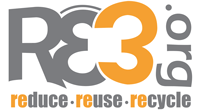N.C. Report: Waste Slows Down, Recycling Speeds Up
by Scott Mouw, CBAS Section Chief
Two positive developments have emerged from the North Carolina Solid Waste Annual Report, submitted in January to the General Assembly by the Divisions of Waste Management and Pollution Prevention and Environmental Assistance. First, the rapid growth in disposed waste so far this century slowed down considerably in fiscal 2007. After jumping almost 2 million tons since 2001, the amount of material entering landfills increased a modest 100,000 tons last year. The decline in the waste growth rate was also enough to decrease the state per capita disposal rate for the first time in six years.
A host of different factors help explain the landfill slowdown, mostly related to the construction and demolition waste stream. Fiscal 2007 saw the beginnings of moderation in the construction market, with a cooling off of housing starts across the state. Second, two large demolition projects – one at Cannon Mills in Cabarrus County and the other at Ft. Bragg – ended in fiscal 2006. These projects helped cause an almost unprecedented jump in disposed tonnage from fiscal 2005 to fiscal 2006 of about 700,000 tons (the only other previous increases along this scale were caused by hurricanes Fran and Floyd).
Beyond the effect of reduced construction and debris tonnage, recycling can claim part of the credit for the decline in waste growth. Local governments in North Carolina set new records in material recovery, for the first time achieving a statewide per capita recycling rate of more than 300 pounds per person. Municipal and county recycling tonnage increased six percent, reaching close to 1.35 million tons – the highest recorded recycling total to date.
Ironically, this growth has occurred as the actual number of curbside recycling programs has declined statewide, mostly due to small towns dropping the service. However, because large urban areas with curbside programs continue to expand, the actual number of households receiving curbside service has stayed the same (and is expected to increase in fiscal 2009 as Fayetteville and a few other cities add curbside). In addition, local governments actually recover more tonnage from drop-off programs than curbside and total local government recovery efforts were helped in fiscal 2007 by a healthy rise in other programs, such as school recycling, electronics collection and commercial/industrial pickup services.
Because no formal state mechanism exists for receiving non-local government recycling data, the Solid Waste Annual Report does not include an overall state recycling rate calculation. But anecdotal evidence suggests that increases in private recycling efforts also may have contributed to the decline in the waste disposal rate in fiscal 2007. Although the data will not be available for a number of months, fiscal 2008 may continue the trend of flat growth in disposal as the economy continues to slow down and as recycling efforts, such as the implementation of the ABC recycling law, increase.
The full report can be viewed online at:
www.wastenotnc.org/swhome/AR06_07/AR06-07.pdf. If you have any questions, contact Scott Mouw at (919) 715-6512 or Jim Hickman at (919) 715-6528.

No comments:
Post a Comment